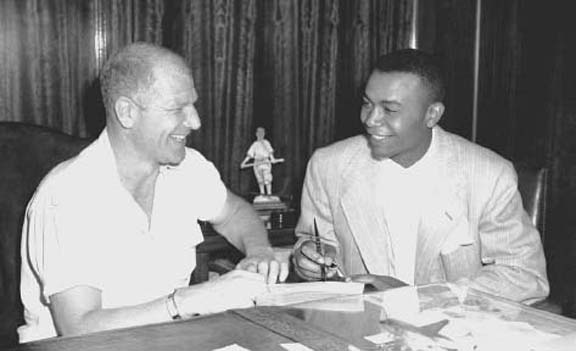July 2017
Edwin Grosvenor and the largely volunteer staff of American Heritage Magazine are pleased to announce the digital publication of a new issue on July 4, 2017, our Nation's birthday, several years after the magazine was forced to suspend print publication during the recession.
The centerpiece of the Summer 2017 issue is an article by two-time Pulitzer Prize winner David McCullough, a former editor at American Heritage, entitled “Hail Liberty!" on the enduring legacy of the famed gift from France that has stood as a beacon of freedom in New York Harbor since its dedication on October 28, 1886. As McCullough writes, “The statue is still there, unrivaled at the gateway. She isn’t a warrior. She isn’t bombastic or threatening. She isn’t a symbol of power. The Statue of Liberty is an act of faith.”
Bartholdi exhibited the arm of his planned statue at the 1876 Centennial Exhibition in Philadelphia -- a decade before it was dedicated in New York harbor. This stereoscope may have been one of numerous promotional efforts to try to raise funds for building the statue's base. While French citizens had donated funds for the huge sculpture itself, it took ten years to find money in the U.S. to build the pedestal.
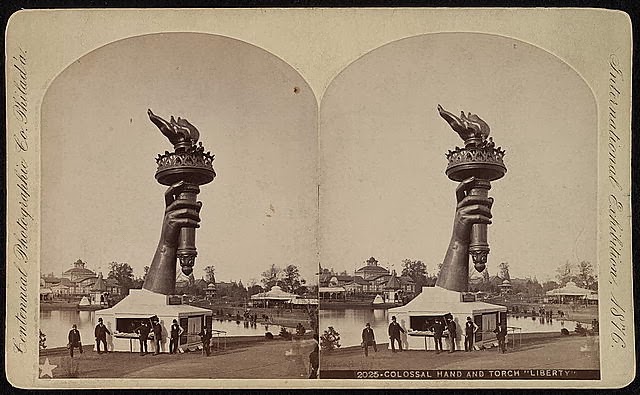
,
The Shrugg Brothers published a print of the planned "Bartholdi colossal statue" in 1884, two years before it was actually completed in New York Harbor.
Library of Congress.
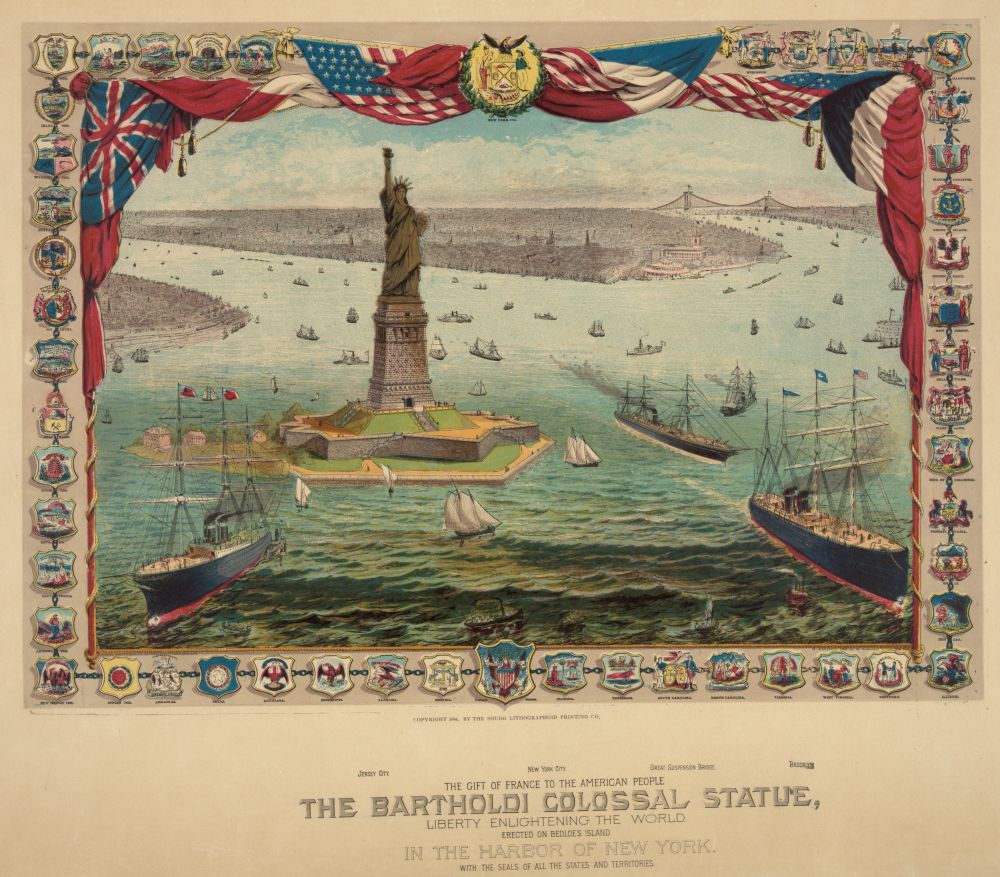
,
Currier & Ives published a print of the original design of Lady Liberty, which included a fanciful lamp to be used as a lighthouse.
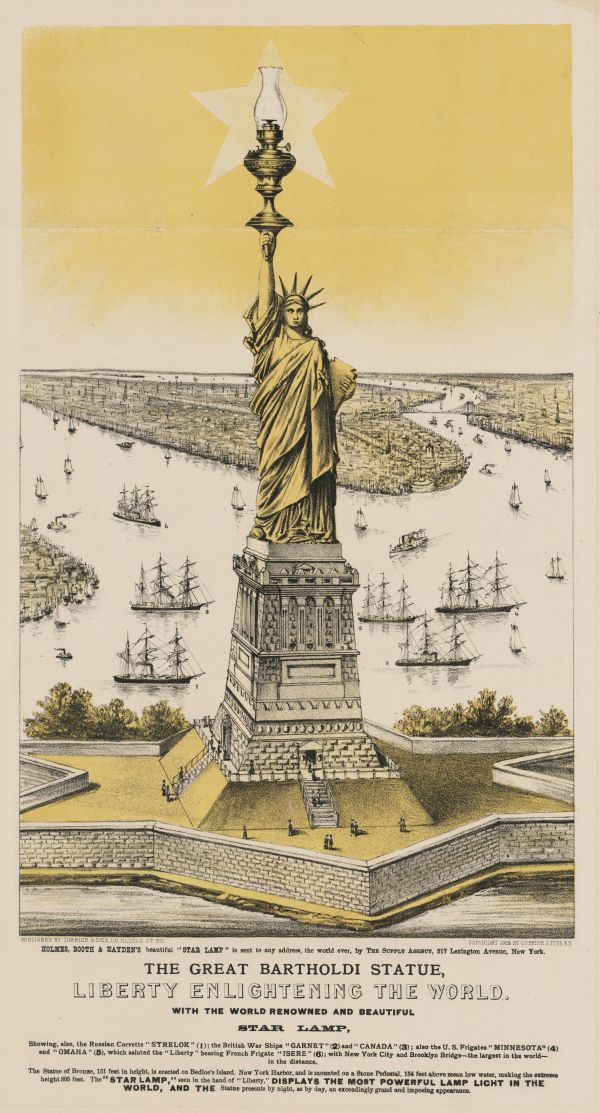
,
The Statue soon became a popular commercial image promoting such products as Holmes & Coutts Famous Sea Form Wafers. Courtesy Wolfsonian/FIU.
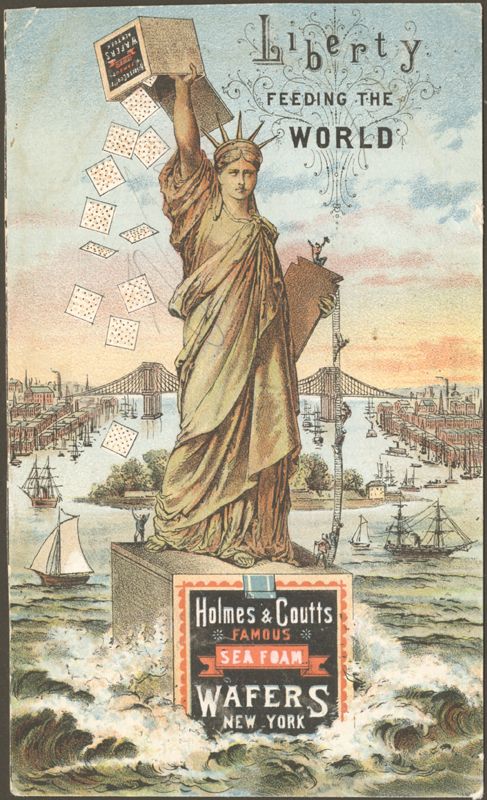
Another commercial use of Liberty was a poster for Brainerd
and Armstrong silk, the "best in the world."
Courtesy Boston Public Library.
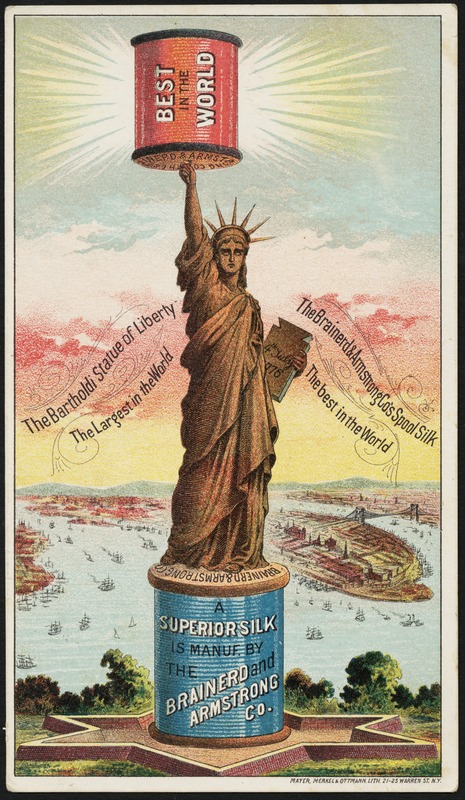
,
An American Collection of sheet music was published with Liberty's image in 1885, before she was even dedicated.
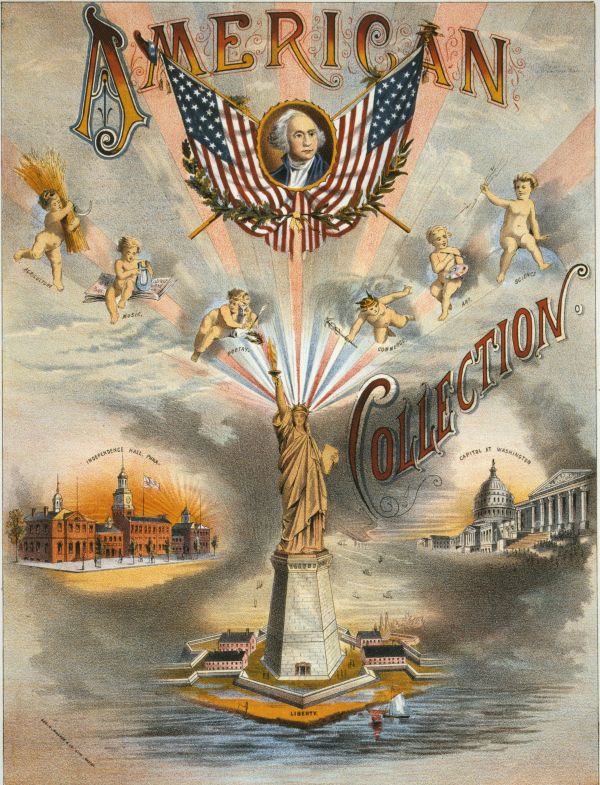
,
Puck Magazine parodied the commercialization of the statue with a Lady covered with endorsements, including "Suredeath" Cigarettes.
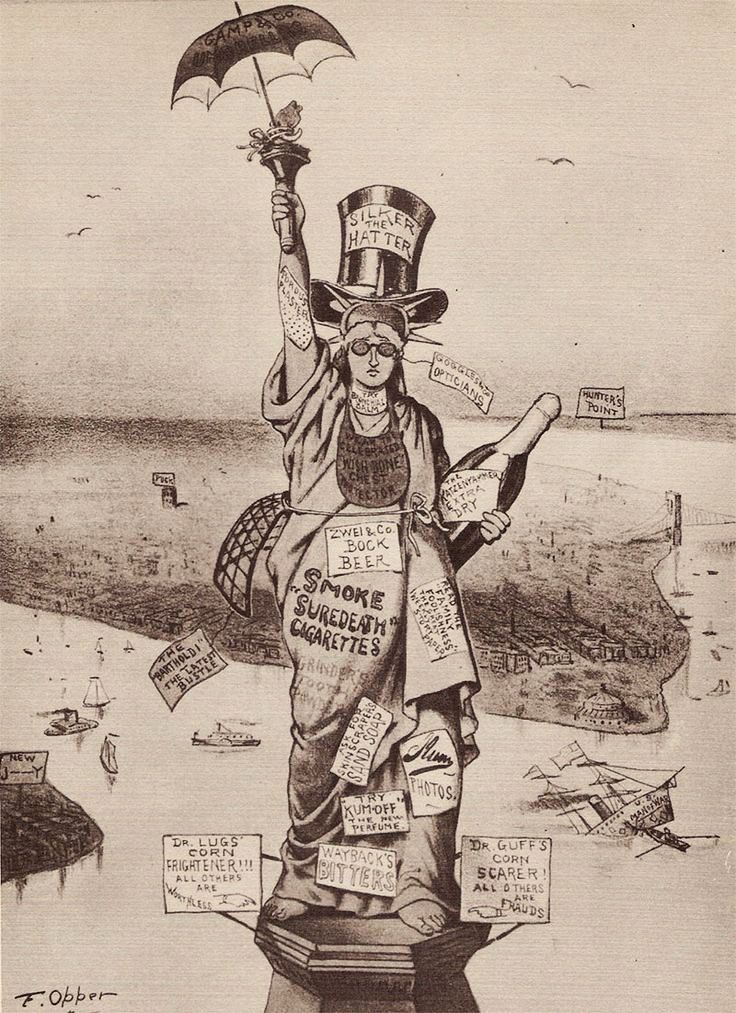
,
Unfortunately, the Statue became a symbol for ugly attacks against immigration. In 1881, five years before Liberty was even dedicated in New York, the Wasp Magazine in San Francisco suggested "A Statue for Our Harbor" -- with a stereotyped Chinese man holding an opium pipe instead of a torch, "filth" and other vices emanating from his head, and rats below. Courtesy of The Ohio State University Cartoon Research Library.
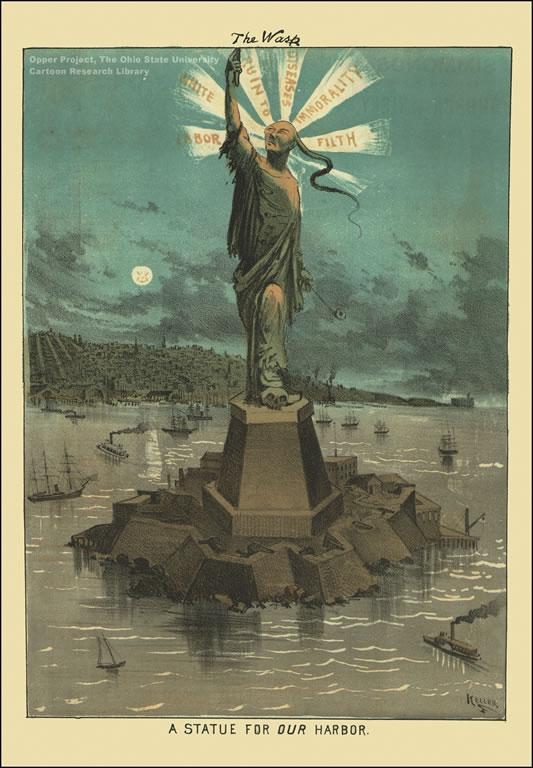
,
During the 1880s and 1890s opposition to immigration among Nativists often surfaced in magazine cartoons such as this one of Uncle Sam grimacing at an onslaught of "socialists", "vagabonds", and "brigands" that appeared in Judge Magazine.
Credit: Library of Congress
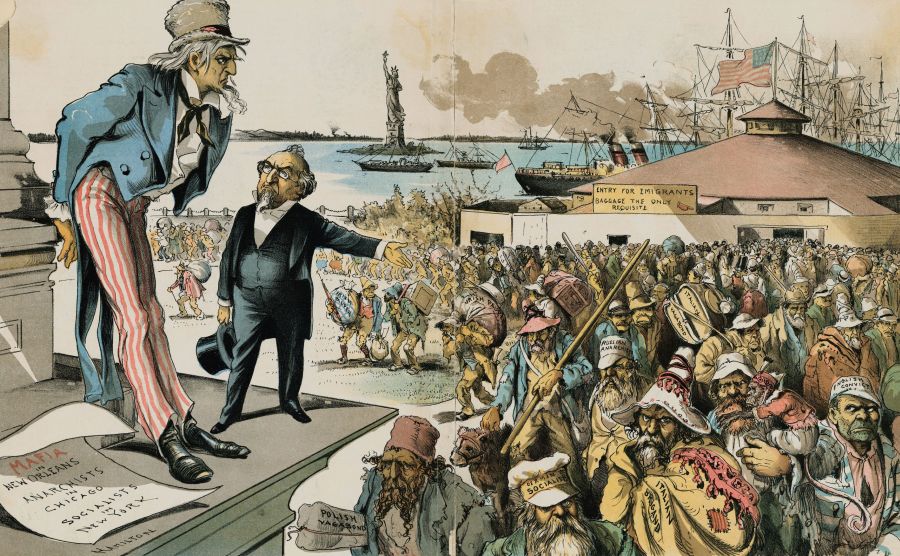
,
When the government planned facilities for processing immigrants on Bedloe's Island, where the Statue stood, Judge Magazine published a cartoon in 1890 entitled "Proposed Emigrant Dumping Site" that showed European ships dumping "garbage" on the island. Courtesy National Park Service.
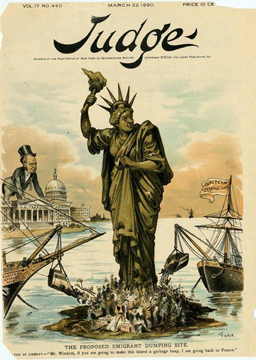
,
The patriotism during World War I meant a much clearer message for Lady Liberty. Courtesy National Archives.
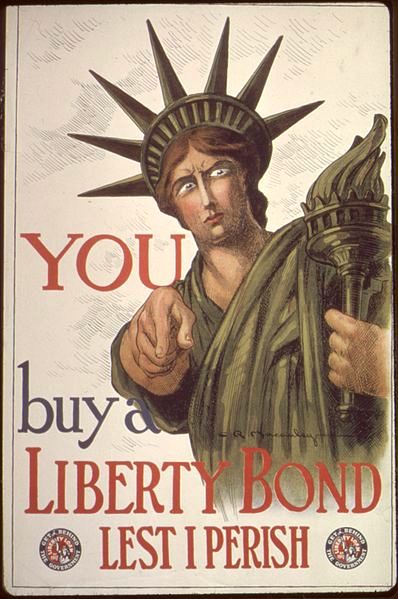
,
The Statue served through all four rounds of Liberty Loans
during World War I. Many posters specifically targeted immigrants.
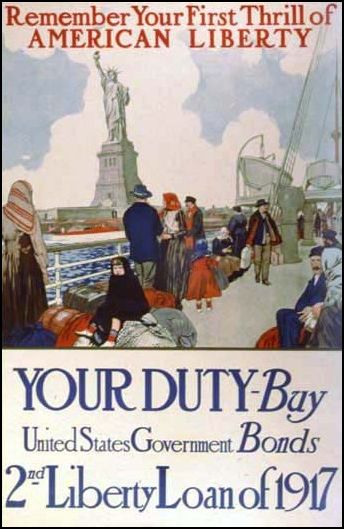
,
Supposedly, 18,000 Iowa National Guardsman were used to create this famous photograph of a quarter-mile tall interpretation of the Statue of Liberty.
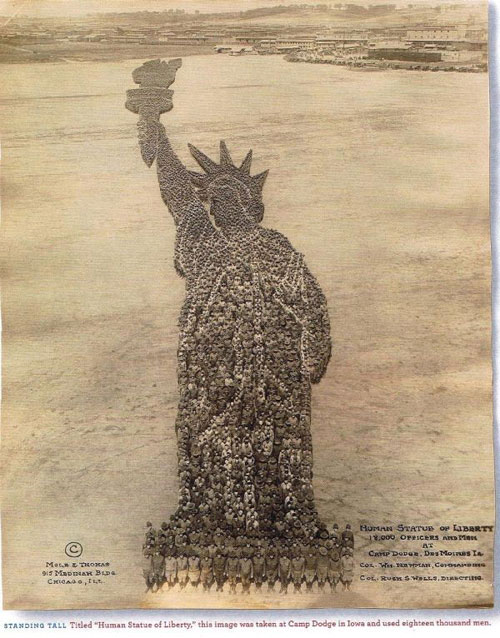
,
Navy recruitment poster in World War I featured a patrol boat passing in front of a prominent Lady Liberty, torch beaming across the sky.
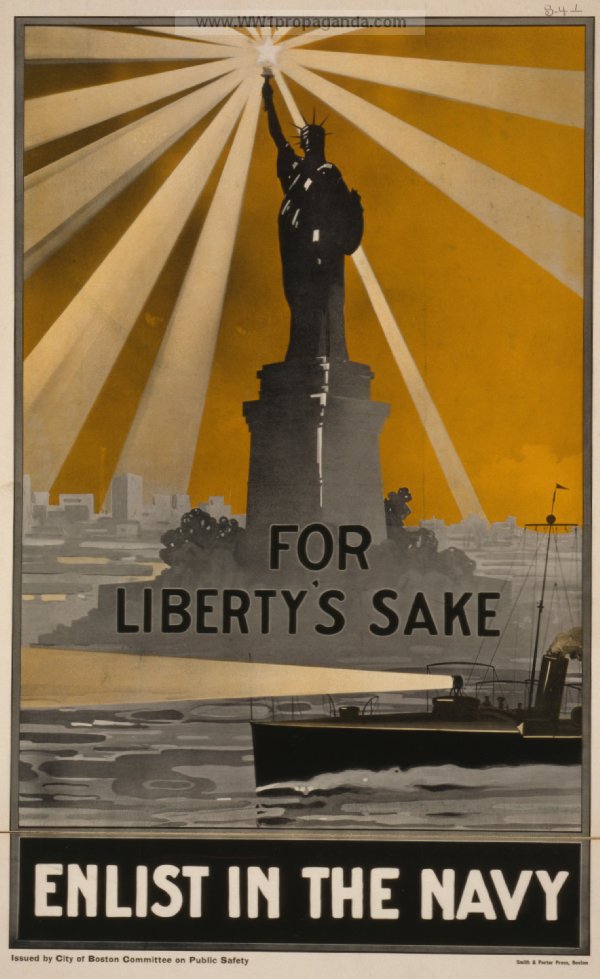
,
A 1916 poster printed in Yiddish stressed the importance of conserving food to aid in the war effort. A translation of the Yiddish reads:
"FOOD WILL WIN THE WAR
You came here seeking freedom
You must now help to preserve it
WHEAT is needed for the allies
Waste nothing"
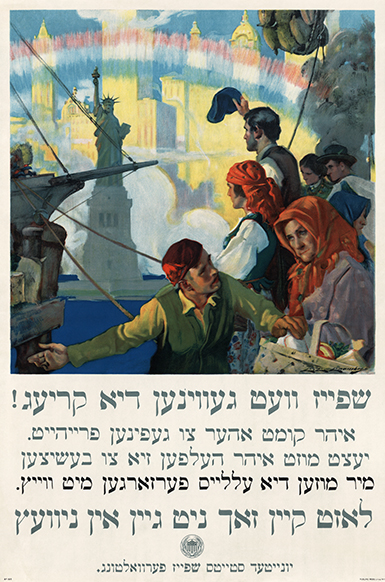
,
Political unrest and wariness towards communism after the Bolshevik Revolution in 1917 inspired this political cartoon by James P. Alley. Originally published in the Memphis Commercial Appeal, it was reprinted in the Literary Digest, July 5, 1919.
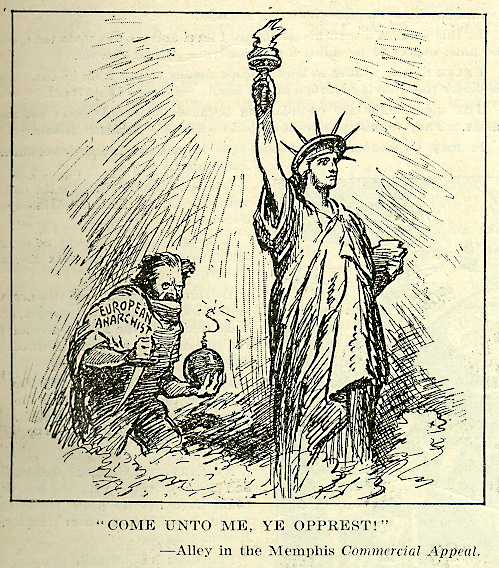
,
The Statue even made it to Broadway. Richard Halls created a poster for WPA Federal Theatre promoting the play “It Can't Happen Here" by Sinclair Lewis and J.C. Moffitt in 1936 or 1937. Work Projects Administration Poster Collection, Library of Congress.
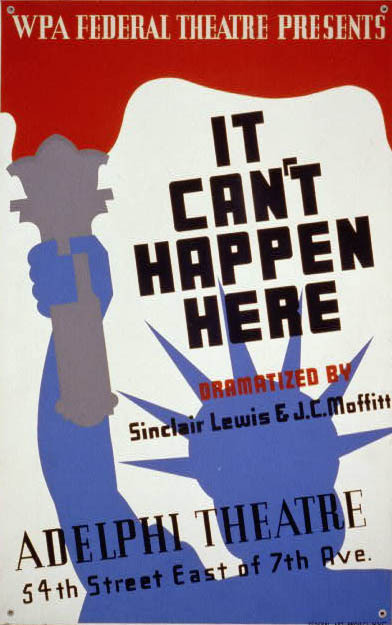
,
Sadly, the Italian artist Gino Boccasile became a supporter of Mussolini during World War II and used his impressive creative talents to make propaganda posters such as this one of a menacing Jewish caricature with the New York skyline in the background, turning the ideals of the Statue upside down. Boccasile drew posters for the Italian SS Division and after the war was imprisoned and tried for collaboration. He had difficulty finding work and died in 1952.
Courtesy of the Wolfonian Collection/FIU.
The Statue of Liberty again became a reminder of America's ideals during World War II, as seen in a Work Projects Administration poster created by Albina Garlinski between 1941 and 1943. Library of Congress.
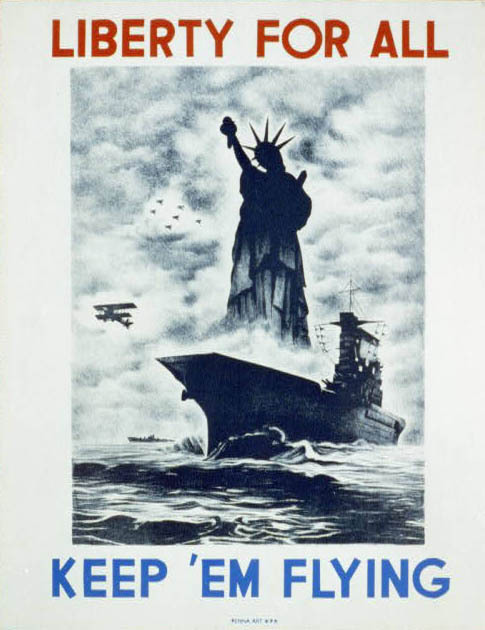
,
Artist Stan Galli created a "Jet Age" tourism poster of the Statue of Liberty for United Airlines in 1960.
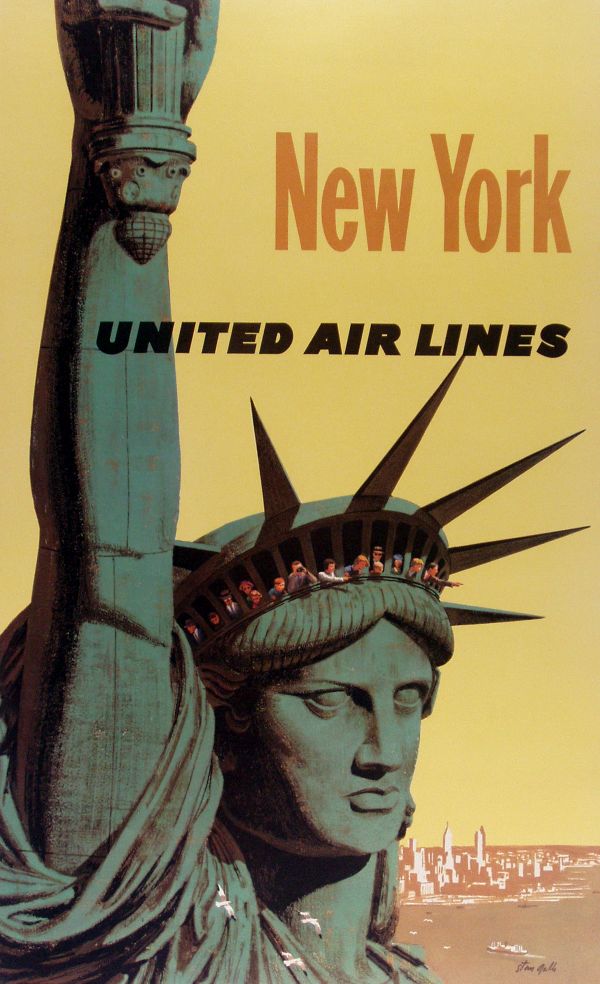
,
A recent exhibit at the British Museum included a Soviet propaganda poster from the 1960s mocking alleged American hypocrisy for the suppression of demonstrations during the 1960s. A billy club hangs from the arm of one of two policemen in the eyes of the Statue.
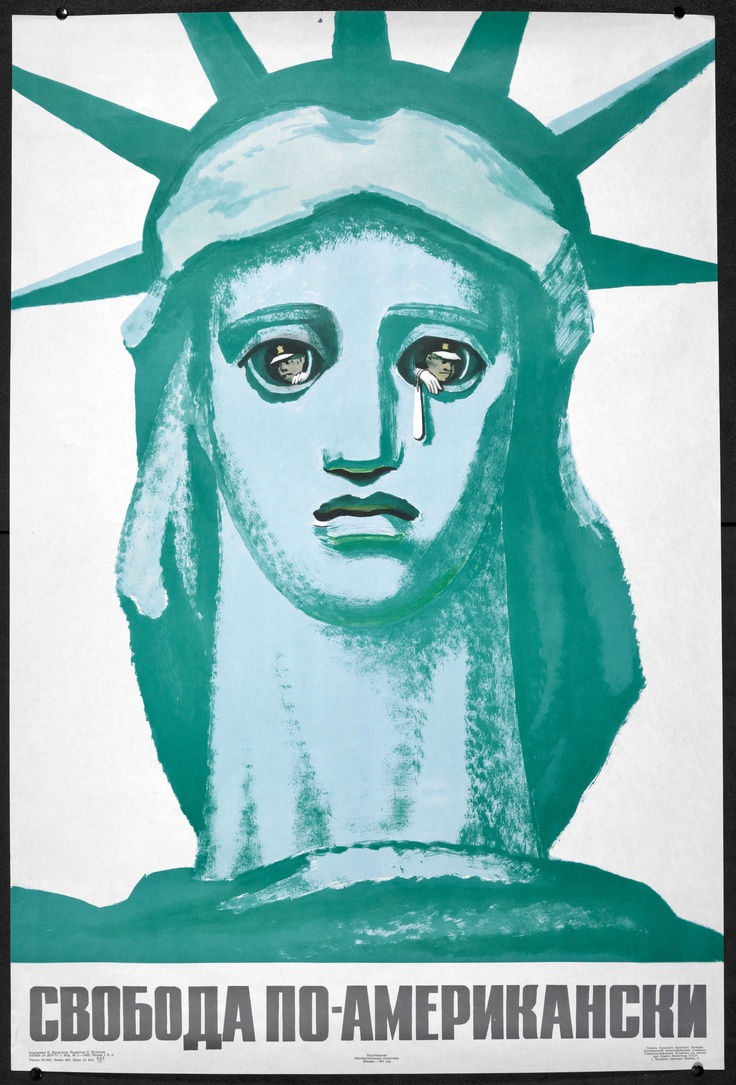
,
On September 11, 2001, dozens of cartoonists across the country created similar images of the Lady Liberty crying,
such as this moving one by Michael Ramirez in The Los Angeles Times.
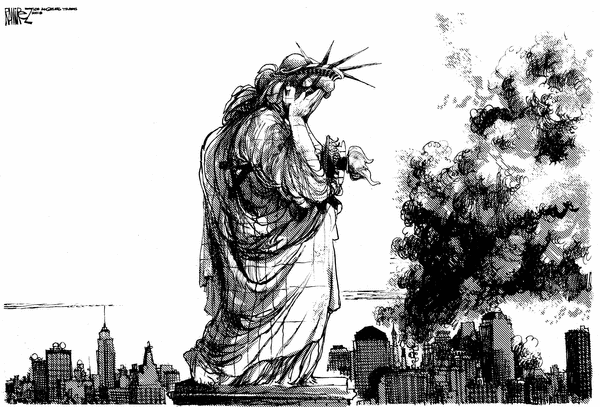
,
As they had before, opponents of immigration used the Statue of Liberty image to make their points. Adam DiOrio created a cartoon showing a giant tsunami of “3 Million Illegal Aliens Per Year” about to hit Liberty. Courtesy of CNS News.com.

,
Trump utters his famous line to Lady Liberty and her huddled masses.
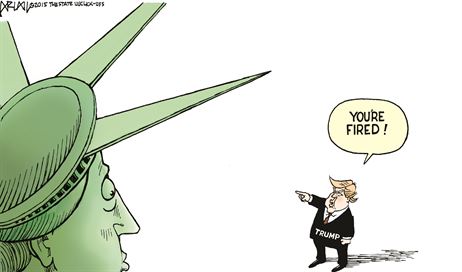
,
A 2014 editorial cartoon in the Los Angeles Times by Pulitzer Prize-winning cartoonist David Horsey took a jab at opponents of immigration with a reference to the iconic lines from the Emma Lazarus poem inscribed at the statue's feet:
"Give me your tired, your poor/|
Your huddled masses yearning to breathe free"
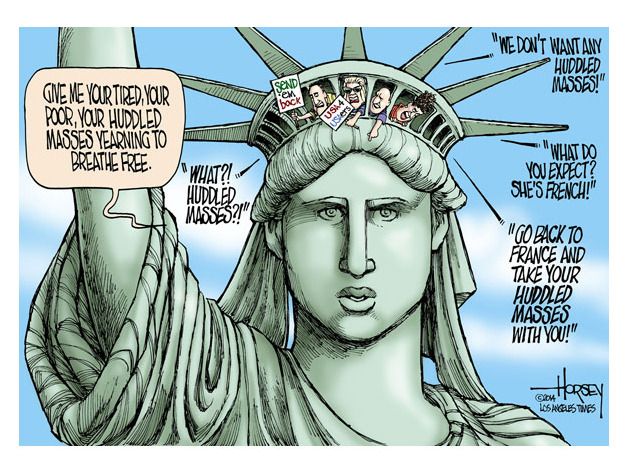
,
Stephen Rustad created a moving cartoon of immigrant children. Courtesy of www.petaluma360.com.
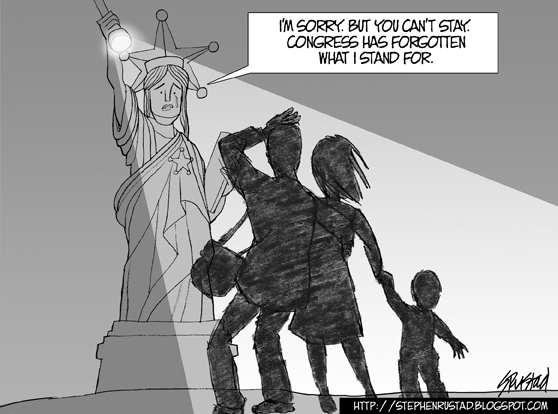
,
Thankfully, the Statue is often used for simple humor. An artist's homage to the famous 1954 "flying skirt" photo of Marilyn Monroe by Sam Show is an ironic combination of
two contrasting female icons. Image courtesy of Worth1000.com.
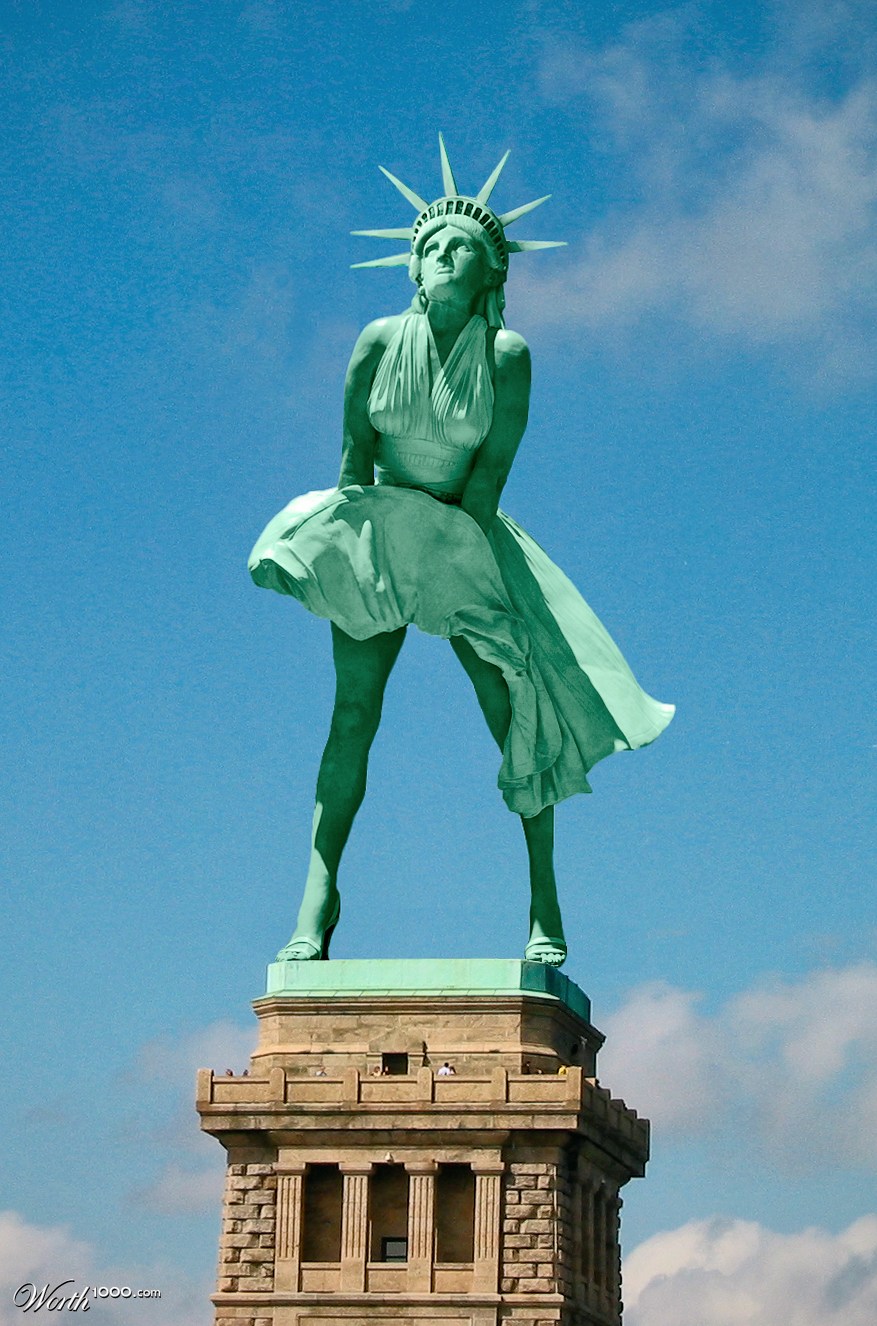
,
The likeness of Lady Liberty can been seen everywhere in New York, and costumed characters in Times Square offer to pose with tourists. The out-of-town tourists don't always realize they're supposed to tip the character, leading to heated exchanges. Photo by Edwin Grosvenor.
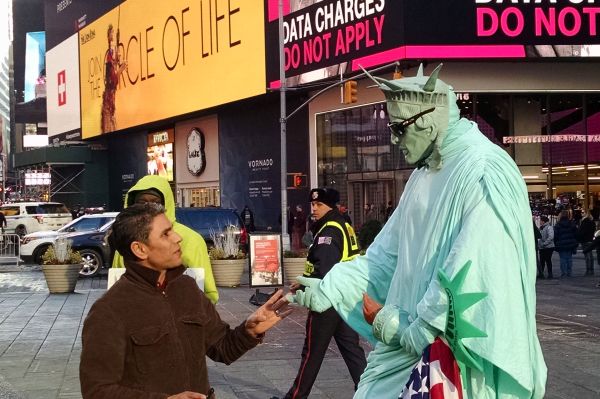
Edwin Grosvenor and the largely volunteer staff of American Heritage Magazine are pleased to announce the digital publication of a new issue on July 4, 2017, our Nation’s birthday, several years after the magazine was forced to suspend print publication during the recession.
The centerpiece of the Summer 2017 issue is an article by two-time Pulitzer Prize winner David McCullough, a former editor at American Heritage, entitled “Hail Liberty!” on the enduring legacy of the famed gift from France that has stood as a beacon of freedom in New York Harbor since its dedication on October 28, 1886. As McCullough writes, “The statue is still there, unrivaled at the gateway. She isn’t a warrior. She isn’t bombastic or threatening. She isn’t a symbol of power. The Statue of Liberty is an act of faith.”
The issue contains important reflections on British Prime Minister Winston Churchill by the late historian John Eisenhower, perhaps the last individual who could remember participating in senior-level meetings among his father, Gen. Dwight D. Eisenhower, Churchill, and other leaders during World War II.
During the Obama Administration, it seemed that one of the few things that Congressional Republicans and the White House could agree upon was cutting history programs. We lost the wonderful Save America's Treasures program (which had funded the restoration of the original Star Spangled Banner, George Washington's tent, Jefferson's papers, and Lincoln's Cottage where the Emancipation Proclamation was written.) And programs such as Preserve America, NEH's We the People, and the Teaching American History grants.
Now the Trump Administration has proposed budget cuts of truly catastrophic proportions for the history community, including a 72% cut to the National Endowment for the Humanities, with plans for its eventual demise.
AmericanHeritage.com is committed to safeguarding your privacy online. Please read the following statement to understand how your personal information will be treated as you make full use of the AmericanHeritage.com Web site. The AmericanHeritage.com Web site is owned and operated by American Heritage Publishing (“American Heritage”).
If you have any questions regarding our privacy statement, please feel free to contact us through the Contact page.
Summary
Our primary goal in collecting user information is to enhance your experience on our Web site. We use aggregated (gathered up data across all user accounts) information to develop content targeted to users’ interests and to better the Web site user experience. American Heritage is committed to your privacy and will not share any personal information with any third party except as set forth in this policy.
What this Privacy Policy Covers
This privacy policy covers the Web site AmericanHeritage.com. Other sites linked to from this Web site, have their own privacy statements which can be viewed on those sites.
Entering the friendly confines of Wrigley Field in Chicago, a first-time visitor cannot help but be struck by the panorama of ivy-covered brick outfield walls, the traditional manually operated scoreboard, and an overall scale and proportion that seems perfect for baseball.
This iconic configuration is the handiwork of the late baseball legend Bill Veeck Jr. His father had been president of the Cubs, and young Bill grew up working for the team during school vacations. When the senior Veeck died unexpectedly in 1933, Bill dropped out of college and was hired by Phillip Wrigley, who had taken over the club the year before.
